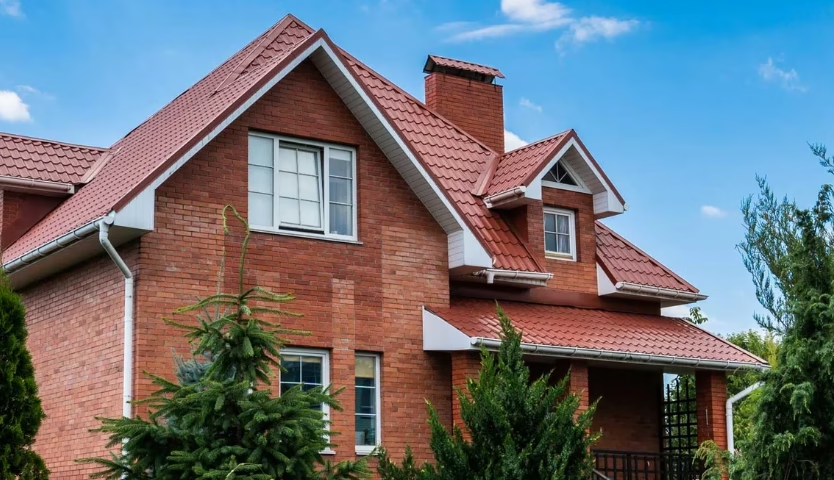The trend towards smaller gardens has inspired the plant lovers’ in the nursery industry to respond with an ever-increasing range of Australian plants that will delight those who want to attract birds and butterflies and bring a little bit of the bush onto their balconies. From banksias to bottlebrush there are plants that will add colour and texture to provide year round interest.
Why Australian native plants for pots?
There is a host of wonderful low growing natives that can add a splash of colour to even the smallest garden. Almost all Australian plants are evergreen which means they tend to keep growing all year round and this often leads to an extended flowering period that has the bonus of attracting wildlife to your garden.
Designing with small Australian native plants
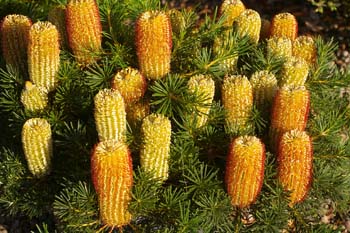
Banksia Coastal Cushion is perfect for pot culture
There is a perception that Australian plants belong in an informal bush garden look when it comes to landscape design. Whilst this is an obvious way to use low growing natives they are very versatile plants that can be used in more creative ways in the garden as well. Some of the dwarf banksias (eg ‘Birthday Candles’) and acacias (eg Acacia cognate ’Bower Beauty’, ‘Moptop’, ‘Green Mist’, ‘Curvaceous’, ‘Fettucine’, ‘Limelight’, ) have interesting linear leaves that can be used to provide the same effect as dwarf conifers but with the added bonus of beautiful blossoms as well. Banksias such as ‘Little Eric’ and ‘Mini Marg’ can be clipped into formal hedges and topiaries as a substitute for box hedges, while cascading types such as Acacia pravissima ‘Kuranga Cascade’ and Acacia baileyana ‘Prostrate’ can be obtained as weeping standards or alternatively make superb features as hanging baskets or spilling over the edge of a long tall pot.
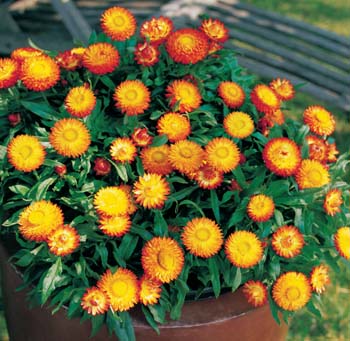
Everlasting daisies like Xerochrysum Sundaze
Bronze provide spectacular colour in pots
Containers will also allow you much greater freedom to design with colour as many of our most spectacular native plants will reach perfection when given the extra drainage that pots provide. The palette available varies from the almost ‘fluoro’ shades of Lechenaultia to the royal blues of dampiera, the bright purples and pinks of the fan flowers (scaevolas), the whites and yellows of paper daisies (Xerochrysum) to the contrast provided by the black kangaroo paw (Macropidia). When designing with such plants think of mixed container plantings in complementary colours such as pinks and mauves or if you want to add some excitement look at contrasts such as yellow everlastings with bright purple fan flowers. The colour of your containers can also be used to enhance such effects.
Caring for Australian native plants
The best thing about these more compact native plant varieties is their easy care nature. They have been specifically chosen for cultivation because of their genetic predisposition to stay small meaning that they rarely need to be pruned. A very light trim to remove the dead flowers is all that is required once a year to keep them looking their best. Most of these varieties need minimal feeding and watering as well although it is important that these aspects are not neglected. Generally speaking a handful or two (depending on plant size) of a slow (controlled) release native plant fertiliser should be sprinkled around the base of the plant after flowering. Iron deficiencies can occur in banksias and wattles and may result from soils that are too alkaline or that are simply iron deficient. The tell-tale signs are a yellowing in the tips of the shoots that can be alleviated within a couple of weeks with a handful of iron sulphate dissolved in a watering can or a dose of iron chelates at the manufacturer’s recommended rate.
It is important to use a potting mix specifically formulated for native plants as plants such as banksias and acacias are known to be sensitive to phosphorous levels. For the same reason always use low phosphorous fertilisers which can be applied after the plants have flowered. This is also the best time to give your potted plants a light haircut with the secateurs, removing any spent flowers and dead foliage. The growth and size of the plant will determine when you need to repot them, generally every couple of years should be enough as these plants tend to stay compact naturally. Use your imagination when it comes to choosing a container. Terracotta containers and tall clay or concrete pipes can make quite novel options that will support the plant for many years.
Watering of your pot plants is a matter of common sense as they do not have the same reserves of moisture to tap into as those in the ground do. Careful observation will teach you that the amount of water required will vary according to several factors. A large plant in a relatively small pot may need watering every day whereas a new planting may only require watering once a week until its roots grow and fill the entire volume of potting mix. Water requirements will also vary on a seasonal basis with much less water required in winter when growth is slow to peak growth in spring and summer when daily watering will usually be the norm. Pots in a very sunny location will also need more frequent watering as will those that are producing masses of flower buds or new shoot growth. The choice of potting mix is also crucial, particularly for long term containers. Look for mixes that are designed for Australian plants and also carry the Australian Standards logo, premium grade carries enough fertiliser to last the plant for about 3 months while regular grade will need fertilising at the time of potting. For an even better result select potting mixes that list wetting agents and moisture storing granules as added extras or alternatively add these yourself at recommended rates.
Australian native plants for pots & small gardens
Wattles are one of the backbones of the Australian flora with their trademark yellow blossoms illuminating the bush at various times of the year. A host of compact varieties have been selected from the many species to provide the gardener with an exciting array of forms and textures that provide interesting design options. There are trailing types such as ‘Kuranga Cascade for hanging baskets or to spill over tall containers (long terracotta pipes provide a lovely earthy look), while the more upright dwarf acacias such as ‘Limelight’ are best used in shorter rounded pots that will give better proportion to these more rounded varieties. These are very quick growing plants that are a great choice for filling gaps in the landscape rapidly, although this feature does seem to shorten their overall lifespan which is generally around the ten year mark. All acacias prefer either full sun or light shade to flower at their best.
Acacia cognata ‘Limelight’ forms a dense mound of linear foliage that provides year round attraction as it invites one to stroke its soft, lime green mop of foliage. It grows to around a metre in height by a couple of metres in diameter. Other similar selections of this species are ‘Mop Top’ and ‘Waterfall’. Acacia pravissima ‘Kuranga Cascade’ and a similar selection ‘Golden Carpet’ both have rather fabulous grey green foliage that spills downwards and outwards and is highlighted with lovely bright yellow flower balls in late winter. These are both prostrate varieties that will reach a diameter of 2 to 3 metres.
Dwarf banksias
One of the fabulous new developments in recent times has been the selection of a range of compact banksias that are tailor-made for pot culture in courtyards and patios. Most of these new banksias have been found in coastal areas where the windswept landscape prunes them into tight buns, a characteristic that is genetically inherited in the new cultivars. The dwarf banksias are perhaps best displayed in squat containers that give a ‘bonsai’ look as their gnarly shape expresses itself over time. Banksias are shrubs that perform best in full sun to part shade and will live for many years.
Banksia spinulosa ‘Birthday Candles’ is perhaps the best known of the new breed of banksias and has a bicoloured flower head with mauve styles contrasting nicely with the yellowish floral tube. Its nectar-filled blooms will attract various birds such as the delicate honeyeaters and spinebills. ‘Coastal Cushion’ and ‘Honeypots’ are other superb forms of the hairpin banksia (B. spinulosa) with similar growth habits to ‘Birthday Candles’ growing to a metre or two in height by a similar width.
Fan flowers (Scaevola)
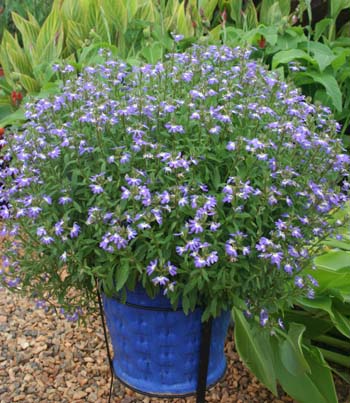
Scaevolas will flower for many months in a pot
Fan flowers (Scaevola species) are perfect for container gardening as they are fast growing and flower for up to nine months of the year, flowering from spring through to autumn and providing spectacular swathes of purple and mauve. The variety ‘Purple Fanfare’ is perfect for hanging baskets but also as a trailing plant for taller pots as its shoots can hang down to a metre. It requires full sun to light shade and requires a regular supply of moisture to flower at its peak. ‘Zig Zag’ is a brand new scaevola that has stunning bicoloured purple and white flowers and requires the same care as ‘Purple Fanfare’. These plants are also great in mixed container plantings where they can be used to provide a colourful complement to more permanent pot plants such as the acacias and banksias.
Lechenaultias
Lechenaultias are one of Australia’s most colourful plants, coming in a rainbow of almost fluorescent shades. They belong to the same family as the fan flowers (Scaevola) and have a similar ground covering to mounding habit with trailing types best for hanging baskets while upright types are best for shallow containers and again as temporary colour in mixed containers. Even though they are perennials, in the more humid climates of Australia it is perhaps best to consider them as annuals that will provide a riot of colour for many months. If and when they start to look untidy they can be readily propagated from tip cuttings to provide a fresh start.
Crowea and Correa
Crowea and Correa both belong to the Citrus family, Rutaceae, which means they usually have interesting scented foliage which complements the striking autumn/winter floral displays.
Croweas have beautiful waxy star-like flowers that last particularly well on the plant as the petals hang on long after the flower has been pollinated. Bindelong Compact is a very low growing plant (30cm high by half a metre wide) with masses of small pink flowers that is best displayed in a shallower type of pot. ‘Southern Star’ and ‘Autumn Lights’ are both relatively new cultivars that have relatively fine dark green foliage that complements the bright pink flowers that continue for several months with a height and width of around half a metre. A deeper container is better for these taller croweas as it will create a better proportioned look which can be under planted with complementary colours from the short lived but very colourful plants such as the mauves and pinks from brachyscome varieties like ‘Mauve Delight’ and ‘Hot Candy’. A light haircut after flowering will help croweas to bush up during spring and summer, ensuring a spectacular flower display for the following season. A handful of slow release fertiliser at pruning time will greatly assist this process as well.
Correas are low growing shrubs that feature beautiful pendulous, bell-shaped flowers in a range of colours. The tubular flowers are designed for bird pollination, so even in small courtyards you can expect regular visits from species of nectar feeding birds. Correas are reliable growers that thrive in dappled light and are best suited to moderately sized pots that can be under planted with some of the colourful herbaceous plants mentioned earlier. Correa ‘Federation Belle’ is an excellent new cultivar that has bicoloured red and green bell-like flowers that appear for several months through autumn and winter. It grows to a height of about half a metre and spreads about a metre in width as do other container loving correas such as the pink ‘Dusky Bells’. Growing requirements and maintenance of correas is identical to that of the croweas, making these two genera ideal garden companions.
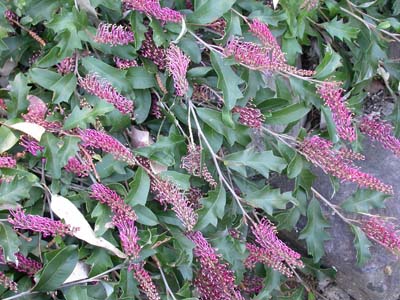
Grevillea Bedspread
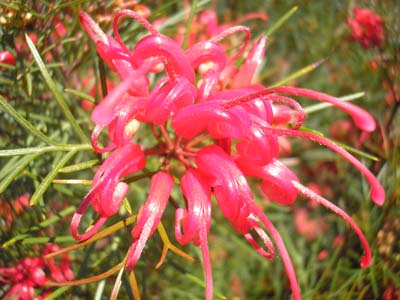 Grevillea Bon Accord flower
Grevillea Bon Accord flowerGrevilleas
Grevillea ‘Lady O’ is a fantastic new compact variety that is perfect for pot culture, producing its red spidery flower heads virtually all year. It grows to around a metre in height by half a metre wide and performs best in light shade and will need a moderately deep container to reach its full potential. Nectar feeding birds such as honey eaters and spinebills make a beeline for the bright blooms that contrasts nicely with the rather dense mid-green foliage. An under planting of the brightly coloured lechenaultias would be the perfect complement for brightly coloured dwarf grevilleas such as ‘Lady O’.
The plants mentioned above are but an appetiser to the ever increasing range of compact, colourful native plants available to those who want a colourful courtyard that will become a haven for any passing birdlife.





